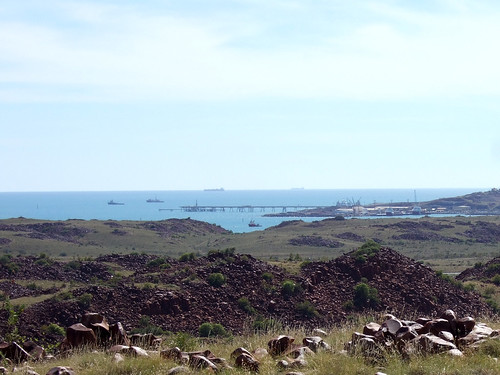The Sweet Smell Of Ammonia
Posted by Big Gav in ammonia, fertiliser, phosphate
The SMH reports that the biggest local sharemarket float of the year will be north west WA based ammonia producer Burrup Holdings - taking advantage of rising fertiliser prices and a nearby large source of gas.
Burrup Holdings, operator of one of the world's biggest ammonia plants, has launched an initial public offering for 20% of the company, looking to raise up to $502 million. ...
Burrup's 760,000 tonnes a year liquid ammonia plant in Western Australia began production in 2006 and accounts for about 6% of the world's total output of tradeable ammonia. Ammonia is a key ingredient in the production of urea, a nitrogen-based fertiliser which is widely used in the agricultural industry.
Yara, the world's biggest ammonia trader, has a 20 year offtake agreement with Burrup to market, distribute and sell its ammonia in domestic and interntional markets. Earlier this month, Yara and Burrup entered an agreement to look into the feasibility of a new 350,000 tonnes a year technical ammonium nitrate plant, used to produce explosives, also on the Burrup peninsula.
The Australian newspaper reported on Monday the planned float had been scaled down after Burrup decided not to sell excess gas from a long-term contract, which would have increased the total offering to up to $608 million. The newspaper said initial plans for the float were put on ice in February because of market turbulence.
Burrup said in a statement it was well positioned to capitalise on favourable global conditions for the sale of ammonia, with prices trading above $500 a tonne. It added it expects the strong price performance to continue.
The Australian's "Pure Speculation" column has more on phosphate production (not to mention potash) along with some sniping at bolshie readers (it kicks off looking at conspiracy theories about the silver market, for those with a liking for shiny metals).
THIS in from reader Geoff Griffiths via Optusnet: "Do some better research before you go shooting your gob off." Nice one, Geoff. This angry reader was appalled by Pure Speculation suggesting investors should be a little discerning about which phosphate plays they back.
Another -- more moderate but no less welcome -- response came from "John B" who argues that the food demand in China and India will put pressure on world fertiliser supplies. Moreover, he continues, phosphate resembles iron ore as the process and economics of mining are similar.
This column was not suggesting otherwise; rather, the point being made is that, yes, phosphate (and potash) are going to become more pricey but, also yes, a bubble was forming in the sector with investors buying stock with the most greenfield of greenfield prospects. A parallel would be the choice 18 months ago between investing in an advanced uranium explorer such as Summit Resources (SMM) or the latest $3 million float based on some moose pasture in the west.
We saw the bounce last week when Korab Resources (KOR) reported it had been approached about developing phosphate at its uranium project in the Northern Territory. Traders went in boots and all, pushing up Korab's price -- but, by Friday, the shares were on the way down again. ...
Saudi Arabia's Maadan Phosphate Co will bring its new fertiliser plant into production in just over two years' time. It will use local phosphate and cheap natural gas.
This first phase will add 2.9 million tonnes a year to the supply of diammonium phosphate (DAP) and will, by itself, tip the DAP global market into surplus, according to Barrie Bain, of the British-based fertiliser consultancy Fertecon.
The second phase will bring production up to 6million tonnes a year, equivalent to half the DAP produced around the world in 2006, according to Middle East Business Intelligence.
Morocco will remain the world's largest exporter of phosphate overall and another fertiliser, monoammonium phosphate. And last week the Moroccans signed a deal with PetroVietnam Fertiliser to build a new DAP plant in the North African country to supply Vietnam and surrounding countries with fertiliser from 2011.
One of Europe's largest producers of phosphate-based chemicals, Nilefos Minerals, is reported to be investing $US535 million to develop a 230 million tonne phosphate deposit in Uganda.
Again, all this doesn't mean that phosphate prices will fail to rise further, that phosphate won't be in deficit at times, and companies producing phosphate won't make good profits. But nor does it mean that every junior who tries to join the phosphate bandwagon is a sure-fire investment.






